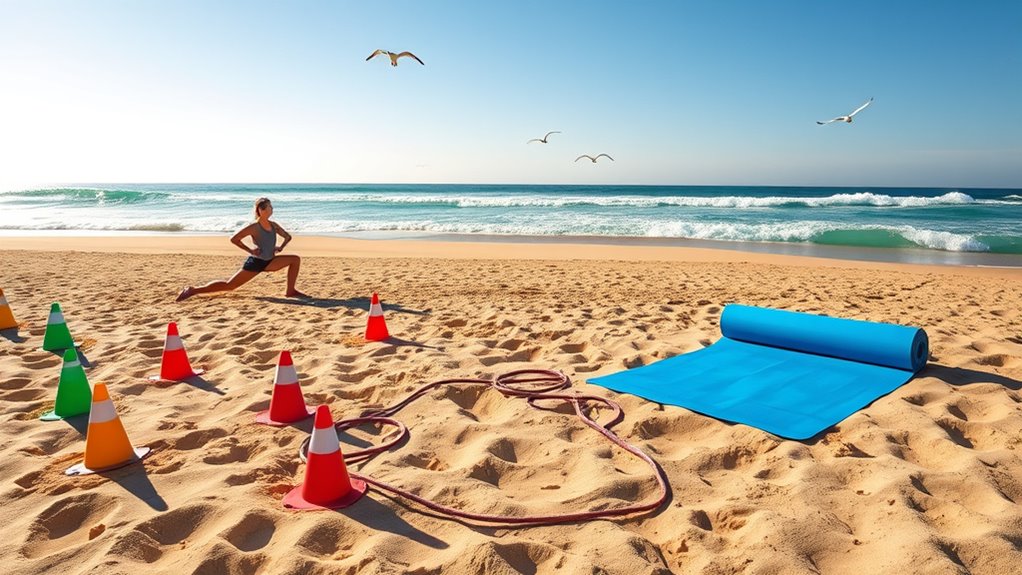To create a beach fitness circuit course, first assess your available space and select weather-resistant equipment like resistance bands or dumbbells, incorporating natural elements such as logs or benches. Define your fitness goals and plan exercises that match, using the shoreline and sand for added resistance. Strategically place stations for smooth flow and safety, with clear markings and instructions. Don’t forget warm-up and cool-down routines, and test your circuit for ideal adjustments—more tips await to help you refine your setup.
Key Takeaways
- Assess beach space and select durable, weather-resistant equipment suited for outdoor use.
- Define fitness goals and plan exercises that target strength, endurance, or flexibility.
- Strategically position stations near natural features, ensuring even spacing and clear flow for safety.
- Use bright markers, signage, and visual cues to guide participants and enhance clarity.
- Test the circuit, adjust exercise intensity, and incorporate warm-up and cool-down routines for safety.
Assess Your Beach Space and Select Equipment
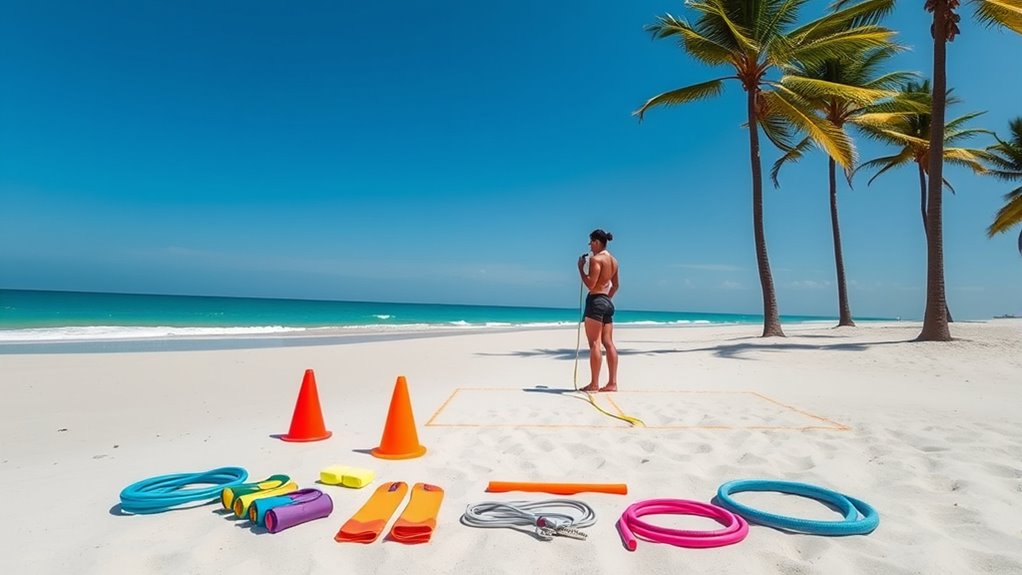
Before setting up your beach fitness circuit, you should evaluate the available space and choose appropriate equipment. Walk along the area to determine how much room you have for different stations. Look for flat, stable spots free of rocks or debris. Measure the space to ensure it fits your planned exercises and allows safe movement. Consider the type of equipment you’ll need, like resistance bands, dumbbells, or jump ropes, which are portable and suitable for outdoor use. You might also want to incorporate natural elements, such as logs or benches. Prioritize lightweight, weather-resistant gear that’s easy to carry and store. Assessing the quality and durability of equipment can help ensure longevity and safety during outdoor workouts. Choosing equipment made from weather-resistant materials is particularly important for outdoor use, as exposure to elements can accelerate wear and tear. Proper assessment helps you create a safe, efficient layout that maximizes your workout and minimizes hazards.
Define Your Fitness Goals and Plan Your Circuit
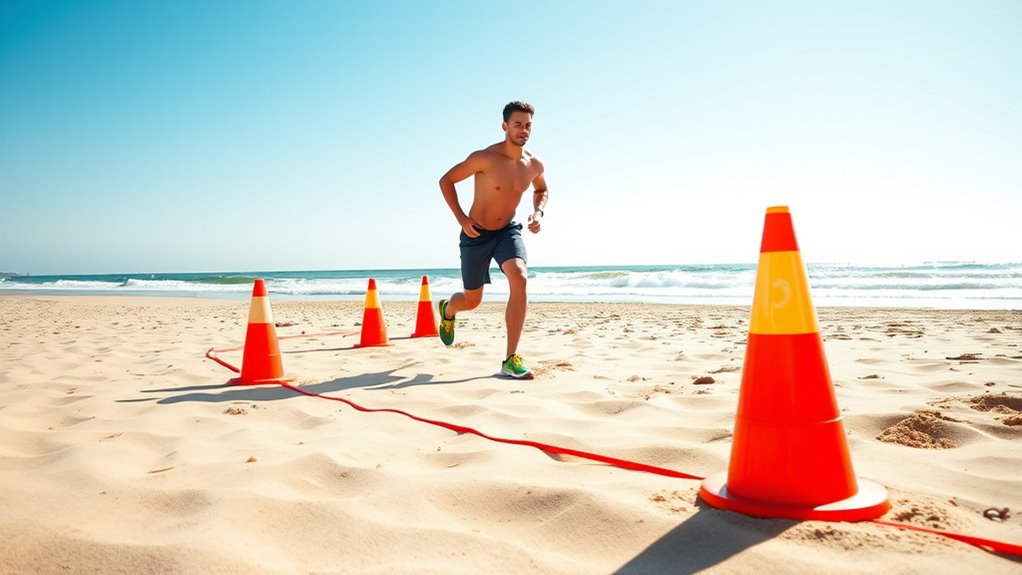
Start by clearly identifying what you want to achieve with your beach workout, whether it’s building strength, increasing endurance, or improving flexibility. Then, select exercises that match these goals to keep your circuit effective and focused. When you plan thoughtfully, you’ll stay motivated and see better results from your efforts. Incorporating proper hydration strategies can also help ensure your hair remains healthy and vibrant after your workout. Additionally, understanding potential risks in merchant services can help you protect your investment in new fitness equipment and technology. Recognizing the importance of ethical hacking principles can also inspire you to incorporate security awareness into your safety protocols during outdoor activities, similar to how Ring security cameras help monitor and secure your space.
Set Clear Objectives
Have you ever wondered why some workout routines feel more effective than others? It’s all about setting clear objectives. When you define your goals, you create a roadmap to guide your circuit. Imagine visualizing your progress through these steps:
- Pinpoint whether you want to build strength, improve endurance, or burn fat.
- Determine how many rounds or minutes you aim to complete during your workout.
- Decide on specific milestones, like running faster or lifting heavier weights.
- Being aware of your regional resources and local environment can enhance your circuit design and motivation.
- Incorporating mental wellbeing principles can boost your motivation and resilience during your fitness journey.
- Focusing on your vibrational energy and maintaining a positive mindset can also help attract desired fitness outcomes.
- Understanding the importance of goal setting and how it influences your motivation can further improve your results.
These targets help you stay focused and motivated. Clear objectives give your session purpose, prevent aimless effort, and track your success. Without them, it’s easy to lose direction or feel discouraged. Set your goals first, then craft your circuit around them for maximum results.
Choose Relevant Exercises
Choosing relevant exercises is essential to guarantee your circuit aligns with your specific goals. First, identify what you want to achieve—strength, endurance, flexibility, or a mix. For strength, include bodyweight moves like push-ups and squats. If you’re aiming for cardio, add jumping jacks or sprints. Flexibility exercises like stretches can be integrated to improve mobility. Keep in mind the beach setting; use natural elements like sand for resistance or stability. Select exercises that match your fitness level and ensure variety to keep motivation high. Prioritizing movements that work multiple muscle groups for efficiency can enhance your overall results. Incorporating pregnancy considerations can help adapt your circuit if needed to accommodate different fitness levels and safety precautions. Additionally, understanding the best soil for String of Hearts plants can be useful if you plan to integrate outdoor or plant-based activities into your routine. Practicing mindful exercise during your workout can also boost mental clarity and enhance your overall experience. By selecting exercises that target your goals, you’ll craft a balanced, effective circuit that maximizes your workout and keeps it enjoyable.
Choose Effective Exercises Suitable for the Beach
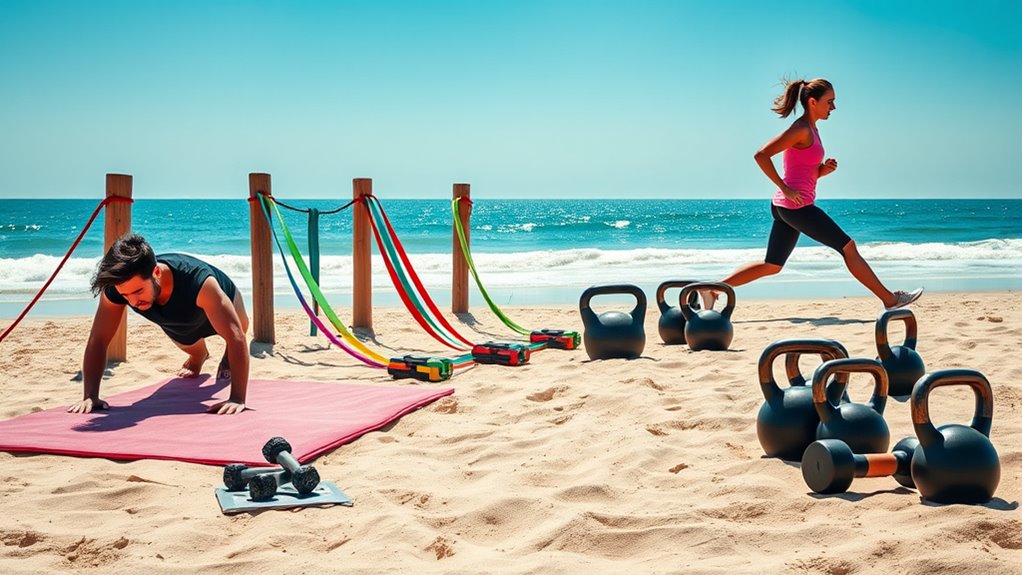
When selecting exercises for the beach, focus on moves that leverage the sandy terrain and outdoor environment to maximize your workout. Sand adds resistance, so choose activities that challenge your stability and strength. For example, consider:
- Sand sprints—run along the shoreline to boost cardiovascular fitness while engaging your core and legs.
- Walking lunges—step forward into lunges across the sand to improve balance and leg strength.
- Push-up variations—perform incline or decline push-ups on the uneven surface to target chest and arm muscles differently.
These exercises utilize the natural resistance of the sand and outdoor space, making your workout more effective and engaging. Keep movements controlled and focus on proper form to prevent injury and maximize benefits.
Arrange Your Stations Strategically Along the Shoreline
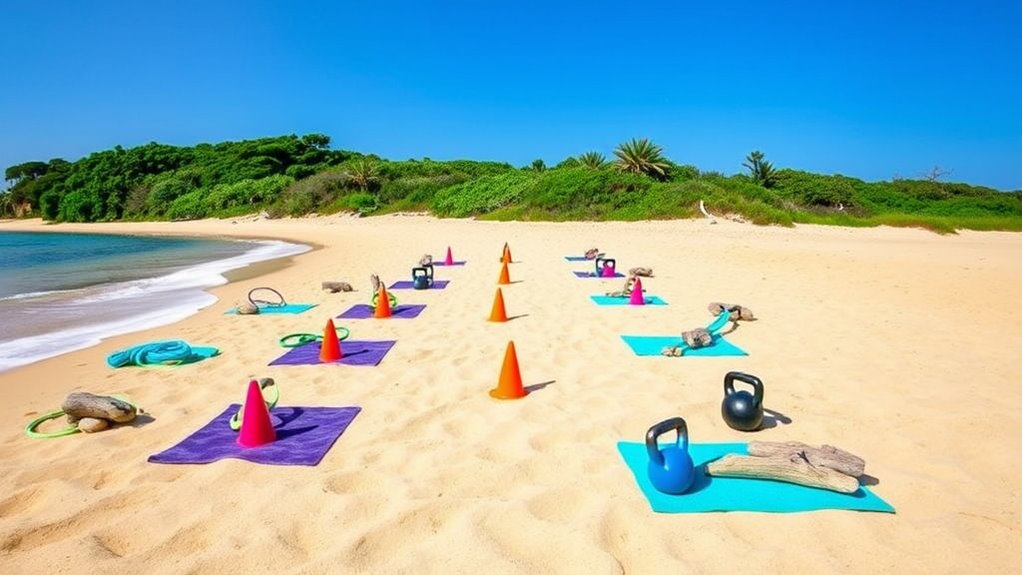
Arrange Your Stations Strategically Along the Shoreline. To create an efficient and engaging beach fitness circuit, you should strategically arrange your exercise stations along the shoreline. Place high-intensity stations, like sprints or jump squats, closer to the water’s edge to utilize open space and maximize energy. Follow with stations requiring more stability or balance, such as planks or yoga poses, further inland where the ground is steadier. Keep transitions smooth by spacing stations evenly, allowing participants to move seamlessly from one activity to the next. Consider natural features like dunes or rocks to serve as markers or resting points. Ensure that stations are visible and accessible, avoiding crowded or unsafe areas. Thoughtful placement helps maintain momentum, minimizes congestion, and keeps participants motivated throughout the circuit. Incorporating vibe coding techniques can also enhance the overall engagement and motivation of participants. Additionally, understanding cybersecurity measures can help protect digital components or apps used for tracking progress and sharing results during group workouts. Using leadership skills during instruction can further boost participant morale and adherence to the fitness routine. Proper planning and placement also help in managing the cookie categories that may be involved with digital tracking tools, ensuring user privacy and compliance.
Set Up Clear Markings and Instructions for Each Station
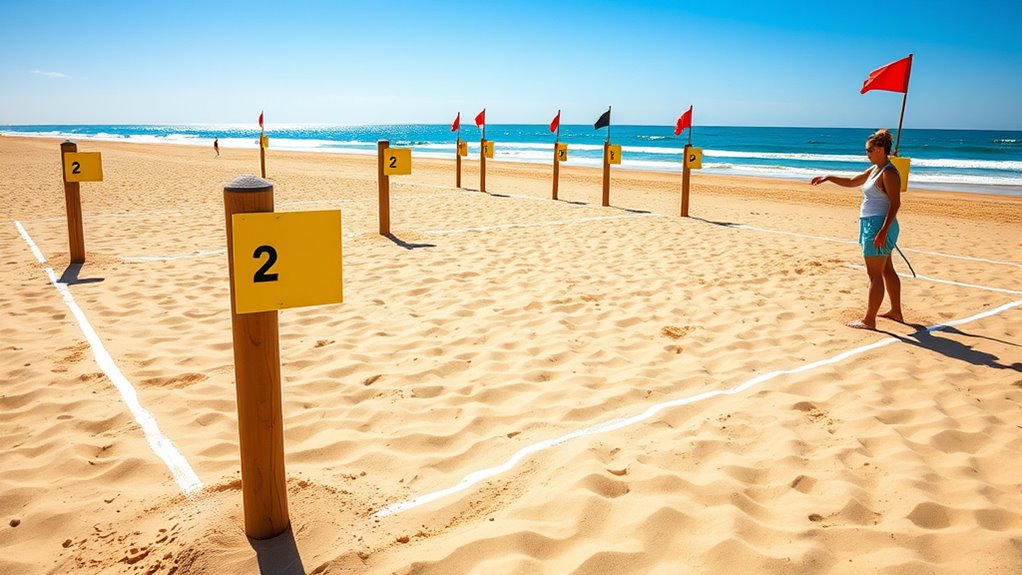
To guarantee participants can easily find and understand each station, you need to set up clear markings and instructions. Use bright, visible markers and label each station clearly so everyone knows where to go. Simple instruction signs will help participants quickly grasp the exercises without confusion. Incorporating high-quality animated movies can also add an engaging element to your course if you choose to include multimedia cues. Additionally, including visual aids related to exercise techniques can enhance understanding and ensure safety during the circuit.
Use Bright, Visible Markers
Bright, visible markers are essential for guiding participants safely through each station of your beach fitness circuit. When markers stand out against the sand and ocean backdrop, everyone knows exactly where to go and what to do. Use bold, colorful flags or cones placed at each station to catch the eye. You could also incorporate large, easy-to-read signs with instructions or icons that clearly convey the activity. Finally, consider using reflective tape or glow-in-the-dark markers for early morning or evening sessions. These markers create a visual map that reduces confusion and keeps the flow smooth. Incorporating rustic decor elements can also enhance the overall aesthetic and make the markers more noticeable. With bright, eye-catching markers, your circuit stays organized, safe, and engaging, making the workout enjoyable for all participants. Recognizing signs of running dry can help you adjust your workout intensity to prevent fatigue. Incorporating visual cues enhances safety and ensures that participants can easily identify each station at a glance.
Include Clear Station Labels
How can you guarantee participants easily navigate each station? The key is to include clear station labels. Use large, bold signs that are easy to read from a distance. Make sure each label clearly states the exercise or activity, like “Jump Rope” or “Push-Ups.” Position these labels at eye level and near the start of each station. Consider using contrasting colors to make labels stand out against the background. Consistent formatting helps participants quickly recognize and understand each station’s purpose. Avoid clutter around labels, so they’re easy to spot. Well-marked stations help prevent confusion, keep the flow smooth, and ensure everyone stays on track. Clear labels create an organized, professional look and boost participants’ confidence as they move through your circuit course.
Provide Simple Instruction Signs
Would participants find it easier to complete each station if instructions are clear and easy to follow? Absolutely. Providing simple instruction signs helps everyone understand what to do without confusion. Use bold, large text and clear visuals for each station. For example, you could include:
- A step-by-step diagram showing the correct form or movement.
- Concise written instructions, like “Jump Rope for 1 minute.”
- Visual icons or illustrations demonstrating the exercise.
These signs should be positioned directly at each station, so participants immediately know what’s expected. Keep instructions brief and straightforward, avoiding jargon. Well-placed signs boost confidence, reduce mistakes, and keep your beach circuit running smoothly. Clear signs are essential for an effective and enjoyable workout experience.
Incorporate Warm-Up and Cool-Down Routines
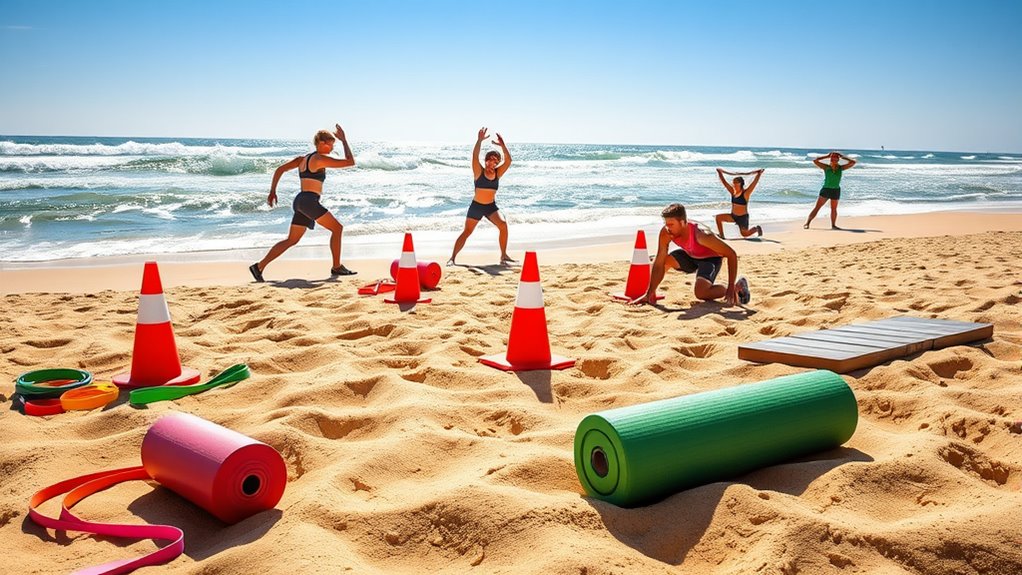
To maximize the benefits of your beach fitness circuit, it’s essential to include warm-up and cool-down routines. Start with dynamic stretches like arm circles, leg swings, and jogging in place to increase blood flow and prepare your muscles. Keep these activities light and gradually build intensity. After completing your circuit, dedicate time to cool down by slowing your movements and doing static stretches for your major muscle groups. Focus on hamstrings, calves, quads, shoulders, and back to promote flexibility and reduce soreness. This progression helps your body recover and prevents injury. Remember, a proper warm-up primes your body for exercise, while a cool-down aids in recovery—integrating both ensures a safe, effective beach workout.
Test Your Circuit and Make Necessary Adjustments
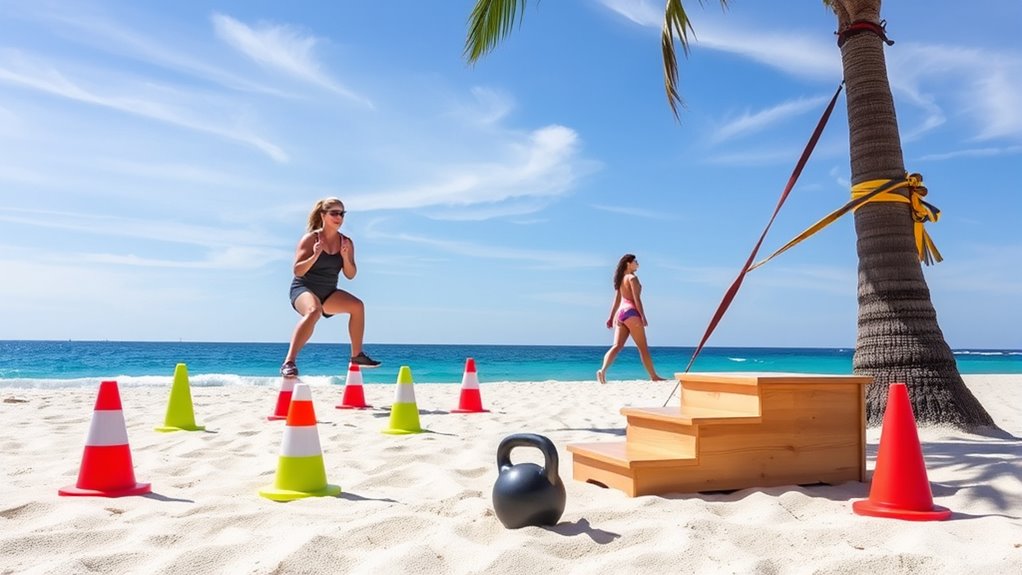
Before fully committing to your beach fitness circuit, it’s important to test the workout to guarantee it challenges you appropriately and flows smoothly. Set up your circuit as planned and go through each station. Pay attention to how long each exercise takes and whether the transitions feel natural. Consider these steps:
- Complete the entire circuit at a steady pace, imagining you’re a participant.
- Note any exercises that seem too easy or too difficult and adjust repetitions or resistance.
- Observe if the sequence feels logical and maintains your energy flow, making changes to improve efficiency.
Testing helps identify bottlenecks or redundancies, ensuring your circuit is balanced, safe, and effective. Make adjustments based on your experience to maximize workout benefits and enjoyment.
Tips for Maintaining Motivation and Safety During Your Workout
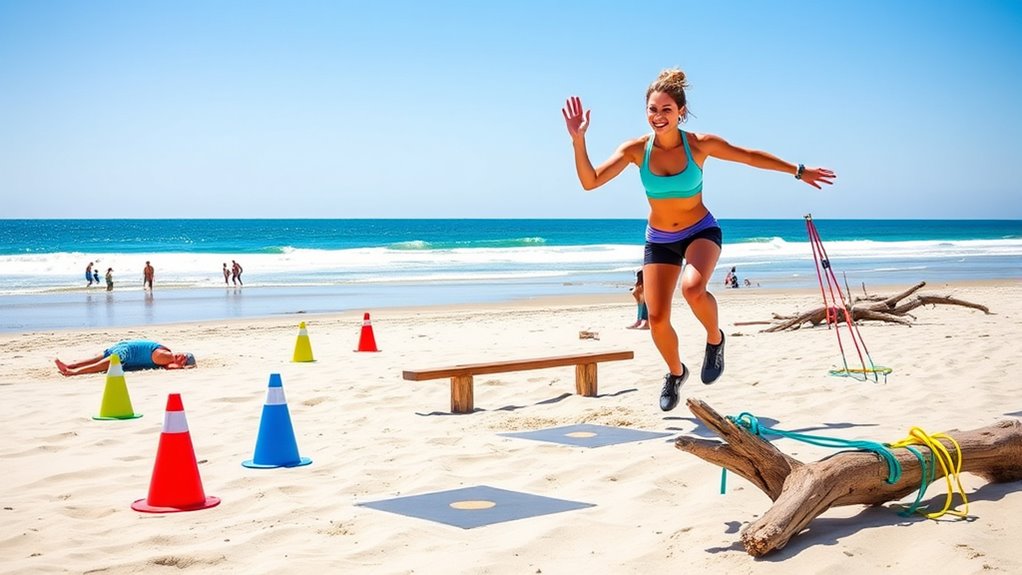
After testing your circuit and making necessary adjustments, maintaining motivation and safety becomes key to sticking with your workout plan. To stay motivated, set clear goals and track your progress; celebrate small victories to keep your enthusiasm high. Mix up your exercises to avoid boredom and keep your body challenged. Always listen to your body—if you feel pain or dizziness, stop and rest. Use proper form to prevent injuries, and don’t push yourself beyond safe limits. Stay hydrated, especially on hot beach days, and wear appropriate footwear to protect your feet. Consider working out with a buddy for accountability and added encouragement. Remember, safety and motivation go hand-in-hand; they ensure you enjoy your workout while reducing the risk of setbacks.
Frequently Asked Questions
How Often Should I Update My Beach Fitness Circuit?
You should update your beach fitness circuit every 4 to 6 weeks to keep participants engaged and challenged. Regular updates prevent boredom and guarantee you’re adapting to their progress. Pay attention to feedback and observe how people perform the exercises. If you notice plateaus or reduced enthusiasm, it’s time to refresh the circuit with new moves or increased intensity. Consistent updates help maintain motivation and maximize results.
Can I Include Water-Based Exercises in My Beach Circuit?
Sure, because who doesn’t want to splash around while getting fit? Water-based exercises are perfect for your beach circuit—they add variety, reduce joint impact, and make workouts more fun. Think jumping jacks in the shallow waves or resistance exercises using water’s natural resistance. Just remember, water’s unpredictable—so be prepared for some sloppy seconds and sandy third wheels. Embrace the chaos and enjoy your aquatic fitness adventure!
What Weather Conditions Are Unsafe for Beach Workouts?
You should avoid beach workouts during stormy weather, high winds, or heavy rain, as these conditions can be dangerous. Hot, sunny days with high UV levels can also pose health risks like sunburn or heat exhaustion. Always check the weather forecast before heading out, and if conditions seem unsafe—like lightning or strong gusts—it’s best to postpone your workout for safety.
How Do I Modify Exercises for Different Fitness Levels?
A wise saying goes, “Adaptability is key.” To modify exercises for different fitness levels, you should tailor intensity and complexity. For beginners, simplify moves and reduce repetitions, while advanced participants can add resistance or increase speed. Always listen to your body and encourage others to do the same. By adjusting exercises, you guarantee everyone stays challenged yet safe, making your beach workout inclusive and effective.
What Are the Best Times of Day to Exercise on the Beach?
You’ll get the most benefits by exercising on the beach during early mornings or late evenings when temperatures are cooler and the sun isn’t too intense. These times also offer calmer conditions, making it safer and more enjoyable. Avoid midday hours when the sun is strongest, as heat and direct sunlight can cause dehydration and fatigue. Planning your workouts around sunrise or sunset helps you stay comfortable and energized.
Conclusion
Remember, a journey of a thousand miles begins with a single step. By creating your beach fitness circuit thoughtfully, you set yourself up for success and enjoyment. Keep your goals clear, stay motivated, and listen to your body. With a little planning and dedication, you’ll turn the sandy shoreline into your personal gym. So, embrace the challenge and make each workout count—because the best time to start is now, and every effort brings you closer to your fitness goals.

